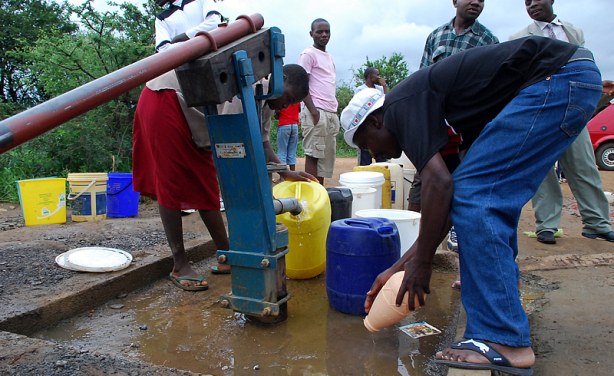


ZIMBABWE’S capital city could turn into a “dust bowl” due to unprecedented poaching of underground water by merchants, who are depleting the water table and creating a potential freshwater crisis, the Financial Gazette can report. The situation for the capital, which harbours the highest population of any town or city in the country, has been worsened by the destruction of major catchments through construction of houses and business premises. These developments have significantly reduced the natural flow of rivers and underground water recharge in most areas.
Besides water being equated to life, dependable water supply is important to an economy because it contributes to economic growth. According to studies, economies are based on engagement in economic activities that produce goods and services. Such interactions depend on water supplies, with individuals requiring it for their health, survival, and lifestyle in order to be productive. Illness, malnourishment, and treatment for water-related diseases take an enormous economic toll on individuals and their communities, according to experts, who contend that water is also crucial for the production of goods.
Investigations by the Financial Gazette revealed that water merchants are ruthlessly harvesting water from both licensed and unlicensed boreholes across the capital, selling it to residents in areas without council water supplies or bottling it for sale on the market. And information gathered by the Financial Gazette indicates that with Zimbabwe’s hot season peaking during the month of October, water bottling companies have upped production in anticipation of increased demand in a city where tap water is scarce and suspiciously unhealthy when available due to lack of adequate resources to treat it.
Groundwater experts warned that the city is heading for a major water shortage, following many years of erratic rainfall of less that 800mm across the country which has largely affected the amount and quality of both underground or groundwater and including that in reservoirs. The city’s last major water crisis occurred in 2008, triggering a nationwide cholera outbreak that resulted in more than 4 000 deaths and affected close to 100 000 people. The United Nations promptly averted further disaster by helping drill boreholes across the city. The boreholes have, however, since either dried up or broken down. A few are still operational.
For Zimbabwe, the international decade for action “Water for Life” that started in 2005 ends next year on a sad note as the country’s capital joins the world’s 1,6 billion people facing severe water scarcity, which is either the lack of enough water (quantity) or lack of access to safe water (quality).
The lingering water scarcity threat has a direct bearing on poverty reduction, economic development and food security, according to the UN which further indicates that by 2025, 1,8 billion people will be living in countries or regions with absolute water scarcity. “With the existing climate change scenario, almost half the world’s population will be living in areas of high water stress by 2030, including between 75 million and 250 million people in Africa. In addition, water scarcity in some arid and semi-arid places will displace between 24 million and 700 million people. Sub-Saharan Africa has the largest number of water-stressed countries of any region,” the UN has concluded.
Harare city’s leafy and opulent northern suburbs that have ironically not received water supplies from the Harare City Council for the past decade or so have sounded alarm bells as boreholes that are as deep as 50 metres dry up. Shallower wells dug in vleis by the city’s high density suburban dwellers are also largely now dry. From as far back as 2007 the city’s northern suburbs have not received tapped water and have solely depended on boreholes.
In a letter, dated September 23, 2014, to chairpersons of the Upper Manyame, Upper Mazowe and Nyagui catchments and copied to the Zimbabwe National Water Authority, the Ministry of Environment, Water and Climate said it had taken over the management of an unspecified number of boreholes that were being used for commercial purposes.
“This decision has been necessitated by the need to protect our infinite groundwater resources which are at risk of being mined by the commercial water operators. You are further advised to take all necessary steps to monitor water levels and water quality and make sure groundwater resources are not depleted,” said the ministry in a letter signed by the permanent secretary for the Ministry of Environment, Water and Climate, Prince Mupazviriho.
Water mining, which is now occurring in Harare on a massive scale, is when collectively more water than is recharged annually by rainfall after runoff and evaporation is abstracted for domestic of commercial use. A groundwater expert, Tim Broderick, noted that chaotic drilling of private boreholes in response to failure by council to supply enough water, notably across the northern suburbs of Harare, has helped deplete Harare’s water table that has further been affected by large-scale abstraction of groundwater for commercial purposes.
“We need a succession of seasons of over 1 000mm per year to make an indent. Underground water in Harare, and everywhere, is a finite resource. Its presence is dependent on the hydrological cycle, which is climate related. It depends on rainfall for its recharge to groundwater storage,” said Broderick.
“Boreholes do not tap into an infinite supply of water, and just ‘drilling deeper’ is not the answer. (It’s) mostly a waste of money,” he further pointed out that all rocks across Harare are of either igneous or metamorphic origin, which makes most of them massive and crystalline in nature and thus classified as ‘hardrock’, effectively meaning that they are impervious and are unable to store water in a primary sense. So in other words the water being drawn from underground is from water that has collected in-between the crevices in the hardrock.
In the absence of any serious developments to improve water supply in the capital by the Harare City Council or government through the construction of new dams and seriously protecting wetlands that help to purify water that replenishes existing reservoirs, the revelations of dwindling groundwater supplies are a strong indicator that it is only a matter of time before chickens come home to roost.
While the capital city and the nation at large seemingly continue to take water for granted, pointers to looming challenges include the simple fact that construction of Kunzvi Dam, east of the capital, has been on paper for over 30 years. The city is currently losing 65 percent of all the water it is purifying through leaks from dilapidated infrastructure. Harare municipality is evidently in no financial position to constantly provide enough fresh water daily for domestic and industrial use as its reservoirs are now too small and highly polluted for a fast growing population estimated to be 2,1 million residents.
New planned and unplanned housing developments, some of them on wetlands, are exerting new pressures on already stressed underground or groundwater supplies and poor funding from government to address the mounting challenges that confront the city in trying to provide enough fresh and clean water has worsened the situation.
newsdesk@fingaz.co.zw